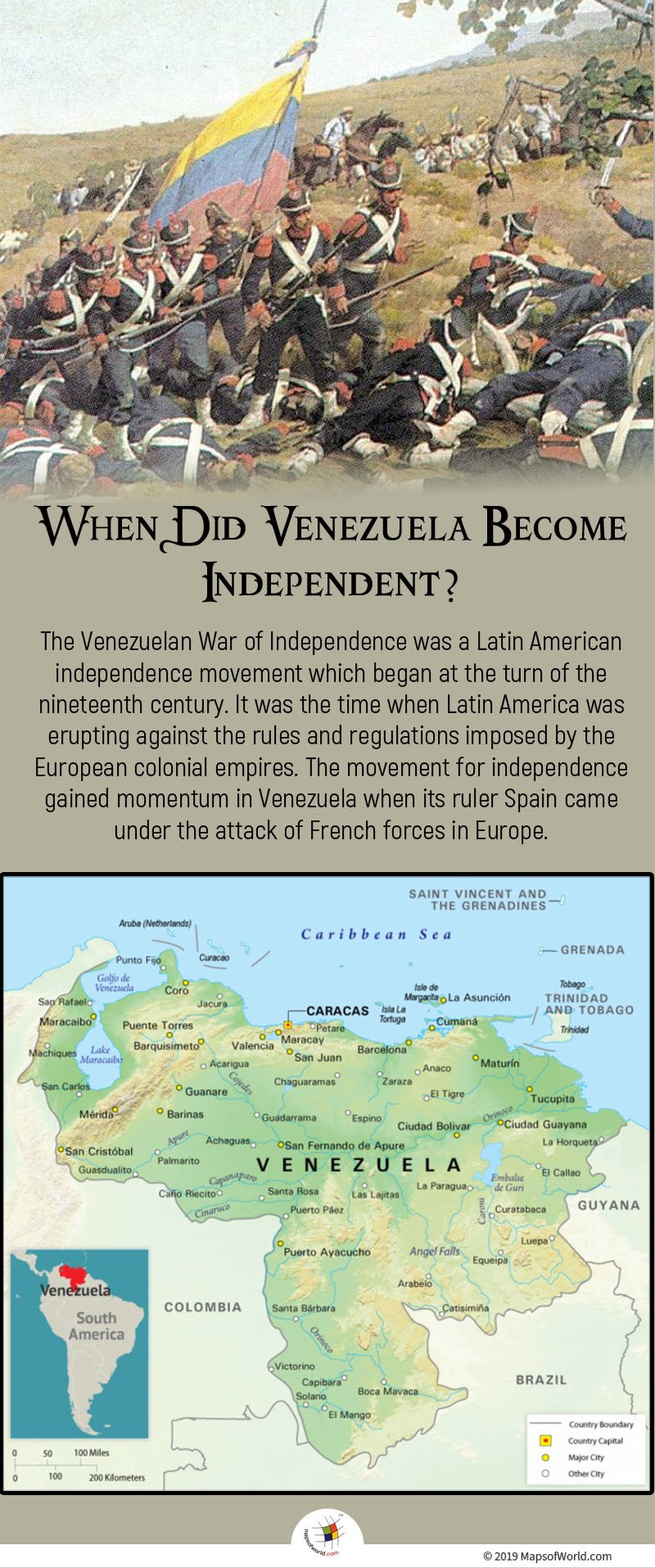When Did Venezuela Become Independent?

The Venezuelan War of Independence was a Latin American independence movement which began at the turn of the nineteenth century. It was the time when Latin America was erupting against the rules and regulations imposed by the European colonial empires. The Spanish empire had relegated Venezuela under the Viceroyalty of New Granada. The economy was predominantly agricultural, with land and wealth concentrated in the hands of a few. Moreover, the rate of taxation rate was high. This led to resentment in the Creoles, who were descendants of the earlier Spanish settlers. The movement for independence gained momentum in Venezuela when its ruler Spain came under the attack of French forces in Europe.
The Adventures of Francisco de Miranda
Miranda was a high ranking Venezuelan General who had participated in the American Revolution against the British, as well as in the French Revolution against Russian forces. Emboldened by his international experience, he cobbled together an army and invaded Venezuela in 1806 to free his homeland. His effort did not succeed, and the Spanish forces managed to repel his attack. However, it ignited the desire for freedom in the local population.
Subsequently, Venezuela made several attempts to gain independence from the Spanish colonial rule. There were two main independence movements: The First Republic which lasted from 1810 to 1812, and The Second Republic which lasted from 1813 to 1814.
The First Republic
The primary factor that fanned the flames of the revolution was the invasion of Spain by the French forces under the leadership of Napoleon Bonaparte. It led to the collapse of the Spanish monarchy in 1808. And Spain took two years to reform the government and establish a new system altogether. Meanwhile, Joseph Bonaparte, the brother of Napoleon Bonaparte and ruler of Spain, appointed colonial officials to govern the Captaincy General of Venezuela.
While Spain was reeling under the French rule, the decline of Spain invigorated Venezuela to show resistance against Spain. As a result, Junta Suprema de Caracas declared provisional independence after the forced deposal of Vicente Emparan as the Captain General of Venezuela on April 19, 1810. This marked the beginning of the Venezuelan war of independence. Revolutionaries such as Simon Bolivar traveled to countries abroad countries such as the United States to gain recognition for the rule of the Junta. The Junta called upon more provinces to join its movement and form a congress of the provinces. On July 5, 1811, the Congress declared the independence of Venezuela from Spain, and its government became known as the First Republic.
However, by the end of 1812, the circumstances started deescalating for Venezuela. The country was witnessing scarcity of monetary support. And the main republican areas were also hit by a cataclysmic earthquake at the same time. Under Spanish attack, Francisco de Miranda succumbed to Spain and signed an armistice in July 1812.
The Second Republic
In the Second Republic, Simon Bolivar along with other republicans kept on pursuing the resistance from other parts of Latin America and the Caribbean. He enlisted a small army in Colombia, and successfully engaged in a series of battles against the Spanish. In August 1813, Bolivar invaded Caracas and promulgated the restoration of the Venezuelan Republic. His victory was aided by the actions of General Santiago Marino, who attacked from the northeastern side. The events led to the establishment of the Second Venezuelan Republic.
However, the victory did not last long. Bolivar was soon conquered by Jose Tomas Boves of the royalist army in 1814. And as a result, the country went back to the royalist control of Spain. Meanwhile, Boves used his locally raised Llanero army to crush the republican forces. The period from 1814-1819 saw bloody battles between the two armies throughout the length and breadth of Venezuela.
Final Defeat of Spanish Forces
In 1819, Bolivar was forced to retreat into the mountains by the Spanish forces. Along with his army, he crossed the snow capped Andes into New Granada (present day Colombia). There, he replenished his army and depleted resources and decided to mount an attack on Bogota, the capital of the Viceroyalty of New Granada. On August 7, 1819, he succeeded in defeating the Spanish forces at the Battle of Boyaca. Thereafter, he assembled a much larger army and launched a battle for Venezuela’s independence. His efforts were supplemented by other generals such as Santiago Marino, Paez and Miguel de la Torre. After the Battle of Carabobo, Venezuela finally gained its independence on June 24, 1821. Spain made another attempt to recapture the country by sending a fleet in 1823. However, their efforts were thwarted at the Battle of Lake Maracaibo.
Related Links:


